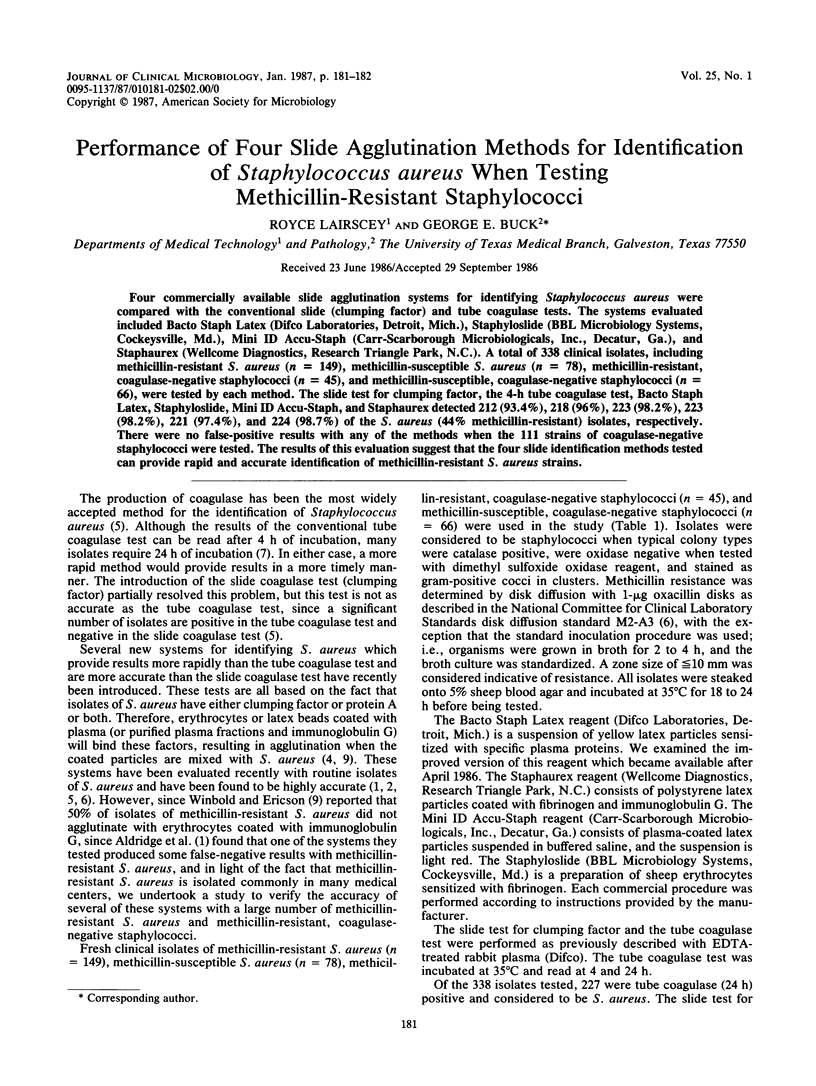Abstract
Four commercially available slide agglutination systems for identifying Staphylococcus aureus were compared with the conventional slide (clumping factor) and tube coagulase tests. The systems evaluated included Bacto Staph Latex (Difco Laboratories, Detroit, Mich.), Staphyloslide (BBL Microbiology Systems, Cockeysville, Md.), Mini ID Accu-Staph (Carr-Scarborough Microbiologicals, Inc., Decatur, Ga.), and Staphaurex (Wellcome Diagnostics, Research Triangle Park, N.C.). A total of 338 clinical isolates, including methicillin-resistant S. aureus (n = 149), methicillin-susceptible S. aureus (n = 78), methicillin-resistant, coagulase-negative staphylococci (n = 45), and methicillin-susceptible, coagulase-negative staphylococci (n = 66), were tested by each method. The slide test for clumping factor, the 4-h tube coagulase test, Bacto Staph Latex, Staphyloslide, Mini ID Accu-Staph, and Staphaurex detected 212 (93.4%), 218 (96%), 223 (98.2%), 223 (98.2%), 221 (97.4%), and 224 (98.7%) of the S. aureus (44% methicillin-resistant) isolates, respectively. There were no false-positive results with any of the methods when the 111 strains of coagulase-negative staphylococci were tested. The results of this evaluation suggest that the four slide identification methods tested can provide rapid and accurate identification of methicillin-resistant S. aureus strains.
Full text
PDF

Selected References
These references are in PubMed. This may not be the complete list of references from this article.
- Aldridge K. E., Kogos C., Sanders C. V., Marier R. L. Comparison of rapid identification assays for Staphylococcus aureus. J Clin Microbiol. 1984 May;19(5):703–704. doi: 10.1128/jcm.19.5.703-704.1984. [DOI] [PMC free article] [PubMed] [Google Scholar]
- Baker J. S., Bormann M. A., Boudreau D. H. Evaluation of various rapid agglutination methods for the identification of Staphylococcus aureus. J Clin Microbiol. 1985 May;21(5):726–729. doi: 10.1128/jcm.21.5.726-729.1985. [DOI] [PMC free article] [PubMed] [Google Scholar]
- Berke A., Tilton R. C. Evaluation of rapid coagulase methods for the identification of Staphylococcus aureus. J Clin Microbiol. 1986 May;23(5):916–919. doi: 10.1128/jcm.23.5.916-919.1986. [DOI] [PMC free article] [PubMed] [Google Scholar]
- Essers L., Radebold K. Rapid and reliable identification of Staphylococcus aureus by a latex agglutination test. J Clin Microbiol. 1980 Nov;12(5):641–643. doi: 10.1128/jcm.12.5.641-643.1980. [DOI] [PMC free article] [PubMed] [Google Scholar]
- Pennell D. R., Rott-Petri J. A., Kurzynski T. A. Evaluation of three commercial agglutination tests for the identification of Staphylococcus aureus. J Clin Microbiol. 1984 Oct;20(4):614–617. doi: 10.1128/jcm.20.4.614-617.1984. [DOI] [PMC free article] [PubMed] [Google Scholar]
- Pourshadi M., Klaas J. Evaluation of latex agglutination and microtube coagulase tests for detection of Staphylococcus aureus. Diagn Microbiol Infect Dis. 1984 Sep;2(4):287–291. doi: 10.1016/0732-8893(84)90059-2. [DOI] [PubMed] [Google Scholar]
- Winblad S., Ericson C. Sensitized sheep red cells as a reactant for Staphylococcus aureus protein A. Methodology and epidemiology with special reference to weakly reacting methicillin-resistant strains. Acta Pathol Microbiol Scand B Microbiol Immunol. 1973 Feb;81(1):150–156. [PubMed] [Google Scholar]


